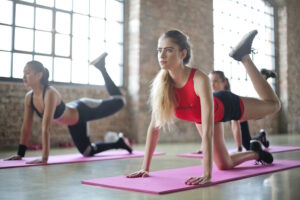
Pilates has gained significant recognition as a valuable training method for athletes looking to enhance their performance and prevent injuries. With its focus on core strength, flexibility, body control, and alignment, Pilates offers numerous benefits that can directly translate to improved athletic performance. In this article, we will explore how Pilates can prevent injuries, its benefits for athletes, its impact on athletic performance and recovery, and its use in rehabilitation.
How does Pilates prevent injuries?
Pilates helps prevent injuries by addressing key aspects of athletic performance, including core stability, flexibility, balance, and body awareness. By strengthening the core muscles, particularly the deep stabilizers, Pilates provides a solid foundation for movement and helps maintain proper alignment, reducing the risk of imbalances and compensatory movements that can lead to injuries. The focus on controlled and precise movements in Pilates helps athletes develop body awareness and improved proprioception, allowing them to move more efficiently and avoid excessive strain on joints and muscles. Additionally, Pilates promotes flexibility, which can prevent muscle imbalances and improve joint range of motion, reducing the likelihood of strains and sprains.
How is Pilates beneficial for athletes?
Pilates offers a range of benefits for athletes across different sports and disciplines. Some of the key advantages include:
1. Core strength and stability: Pilates targets the deep core muscles, providing athletes with a strong and stable center for improved overall strength and power.
2. Flexibility and mobility: Pilates promotes flexibility and joint mobility, enhancing athletes’ range of motion, allowing for better technique and reducing the risk of injuries.
3. Body control and alignment: Pilates focuses on precise movements and alignment, helping athletes develop better body control, coordination, and posture.
4. Injury prevention: By addressing imbalances, strengthening weak areas, and improving overall body awareness, Pilates helps athletes prevent injuries and maintain optimal performance.
What improves athletic performance, prevents injuries, and helps with recovery from exercise?
Pilates improves athletic performance by enhancing core strength, flexibility, balance, and body control. A strong core provides a solid base for generating power and transferring force efficiently during athletic movements. By improving flexibility, Pilates helps athletes achieve optimal joint range of motion, allowing for more fluid and efficient movements. The focus on body control and alignment enhances athletes’ overall coordination, stability, and technique, leading to improved performance and reduced risk of injuries. Additionally, Pilates can aid in recovery from exercise by promoting circulation, relieving muscle tension, and facilitating proper post-workout recovery.
What is the use of Pilates in rehabilitation?
Pilates is widely used in rehabilitation settings due to its gentle yet effective nature. The principles of Pilates, including core activation, controlled movements, and emphasis on proper alignment, make it a valuable tool for rehabilitating injuries. Pilates exercises can be tailored to target specific areas of weakness or imbalances, helping athletes regain strength, flexibility, and coordination after an injury. The low-impact nature of Pilates is particularly beneficial during the rehabilitation process, as it minimizes stress on injured areas while still challenging the body. Moreover, the mind-body connection cultivated in Pilates promotes mental focus and resilience, aiding athletes in their recovery journey.
Pilates is a valuable practice for athletes seeking to enhance their performance, prevent injuries, and aid in recovery. By focusing on core strength, flexibility, body control, and alignment, Pilates provides athletes with the tools to improve their overall athleticism and reduce the risk of injuries. The benefits of Pilates include enhanced core stability, improved flexibility, better body awareness, and injury prevention. Moreover, Pilates can be used as a rehabilitation tool to help athletes recover from injuries and regain strength and function. By incorporating Pilates into their training regimen, athletes can optimize their performance, stay injury-free, and achieve their goals in their respective sports or activities.